Tetramorium simillimum
| Tetramorium simillimum | |
|---|---|

| |
| Scientific classification | |
| Kingdom: | Animalia |
| Phylum: | Arthropoda |
| Class: | Insecta |
| Order: | Hymenoptera |
| Family: | Formicidae |
| Subfamily: | Myrmicinae |
| Tribe: | Crematogastrini |
| Genus: | Tetramorium |
| Species group: | simillimum |
| Species: | T. simillimum |
| Binomial name | |
| Tetramorium simillimum (Smith, F., 1851) | |
| Synonyms | |
| |
| Common Name | |
|---|---|
| Sazanami-shiwa-ari | |
| Language: | Japanese |
A tramp species that is now pantropically distributed. It even occurs in some temperate areas, albeit in protected locations such as heated greenhouses.
| At a Glance | • Highly invasive • Polygynous |
Identification
A member of the Tetramorium simillimum species group.
Very similar to Tetramorium caldarium, as detailed in the identification section of this other species.
Weakly sculptured, pale red much smaller than Tetramorium guineense. Length: 1.6-2 mm (Collingwood 1979).
Bolton (1977) - T. simillimum is a small, quite common pantropical tramp species of African origin which is also found as an introduction in hothouses and zoological gardens in the temperate zone. A number of related species are known from the Ethiopian region but none of these occurs outside Africa. The distinctive sculpture and short, stout pilosity will differentiate simillimum from other species in the Oriental and Indo-Australian regions.
Bolton (1980) - Within the group T. simillimum is closest to Tetramorium delagoense, Tetramorium bothae and Tetramorium rhetidum, sharing the characters of strongly developed scrobes and frontal carinae and dense ground-sculpture. Its separation from these species is discussed under their respective descriptions.
Tetramorium simillimum is not a particularly variable species but West African populations tend to have the head at the lower end of the width-range given above, giving them a relatively high CI. There is also a tendency in these forms to develop a gaster which is distinctly darker in colour than the head and alitrunk.
Keys including this Species
- Key to Australian Tetramorium Species
- Key to US Tetramorium species
- Key to Micronesian Ants
- Key to Arabian Tetramorium
- Key to Tetramorium of India
- Key to Afrotropical Tetramorium species groups
- Key to Tetramorium of the southwestern Australian Botanical Province
- Key to Afrotropical Tetramorium simillimum species group
- Key to workers of the Socotra Archipelago, Yemen
- Key to Hispaniola Genera of Myrmicinae
- Key to Tetramorium of Hispaniola
Distribution
Latitudinal Distribution Pattern
Latitudinal Range: 29.966667° to -33.65°.
| North Temperate |
North Subtropical |
Tropical | South Subtropical |
South Temperate |
- Source: AntMaps
Distribution based on Regional Taxon Lists
Afrotropical Region: Cameroun, Comoros, Eritrea, Ethiopia, Guinea, Ivory Coast, Kenya, Malawi, Mozambique, Nigeria, Rwanda, Socotra Archipelago, Uganda, United Republic of Tanzania, Yemen, Zambia.
Australasian Region: Australia, New Caledonia, Norfolk Island.
Indo-Australian Region: Borneo, Cook Islands, Fiji, Guam, Hawaii, Indonesia, Kiribati, Krakatau Islands, Malaysia, Marshall Islands, Micronesia (Federated States of), New Guinea, Niue, Northern Mariana Islands, Palau, Philippines, Samoa, Solomon Islands, Tokelau, Tonga, Vanuatu, Wallis and Futuna Islands.
Malagasy Region: Madagascar, Mauritius, Mayotte, Réunion, Seychelles.
Nearctic Region: Canada, United States.
Neotropical Region: Barbados, Bermuda, Brazil, Costa Rica, Cuba, Dominican Republic, Ecuador, French Guiana, Galapagos Islands, Greater Antilles, Grenada, Guadeloupe, Haiti, Mexico, Paraguay, Puerto Rico.
Oriental Region: Bangladesh, India, Sri Lanka, Thailand.
Palaearctic Region: China, Denmark, Estonia, Iran, Israel, Japan, United Kingdom of Great Britain and Northern Ireland (type locality).
Distribution based on AntMaps
Distribution based on AntWeb specimens
Check data from AntWeb
Countries Occupied
| Number of countries occupied by this species based on AntWiki Regional Taxon Lists. In general, fewer countries occupied indicates a narrower range, while more countries indicates a more widespread species. |

|
Estimated Abundance
| Relative abundance based on number of AntMaps records per species (this species within the purple bar). Fewer records (to the left) indicates a less abundant/encountered species while more records (to the right) indicates more abundant/encountered species. |

|
Biology
Regional Notes
Australia
The range for Tetramorium simillimum given by Brown and Taylor (1985) is probably understated. Unlike some other exotic myrmicines in Australia, this species does not seem to adversely affect the native ant fauna.
Bahamas
Wheeler (1905) - This tropicopolitan species is common in certain localities near settlements both on Andros and New Providence. At Nicholl's Town, on the eastern coast of the former island, I found it in and under rotting coconut boles that had been prostrated some years ago by a hurricane. These nests contained many males and winged females (May 14). On New Providence the species was common under stones in the Queen's Staircase in Nassau, in the Menendez Sisal Plantation near Stanley, and in the dwindling 'pine yards' near the Blue Hills.
Europe
Collingwood (1979) - This cosmopolitan species occasionally occurs in heated glasshouses in Europe and has been recorded from Denmark and also on several occasions in England.
Puerto Rico
Wheeler (1908) - In Culebra a few colonies were found nesting under stones and logs on the beach, in Coamo Springs several colonies were seen under stones in the creek bottom near the baths.
Florida USA
A common species found as far north as St. Johns County, Florida. Nests are usually in soil in open areas, often around buildings or parking lots. Pest status: none. First published Florida record: Wheeler 1932. (Deyrup, Davis & Cover, 2000.)
Socotra, Yemen
Sharaf et al. (2017) - Workers of this species were found foraging on the soil under thrown, dry, date palm fronds. Several workers were found foraging on the ground under grasses.
Association with Other Organisms
 Explore: Show all Associate data or Search these data. See also a list of all data tables or learn how data is managed.
Explore: Show all Associate data or Search these data. See also a list of all data tables or learn how data is managed.
- This species is a host for the cestode Raillietina echinobothrida (a parasitoid) (Quevillon, 2018) (encounter mode secondary; indirect transmission; transmission outside nest).
- This species is a host for the cestode Raillietina tetragona (a parasitoid) (Quevillon, 2018) (encounter mode secondary; indirect transmission; transmission outside nest).
Life History Traits
- Queen number: polygynous (Frumhoff & Ward, 1992)
Castes
Worker
Images from AntWeb
   
| |
| Worker. Specimen code casent0102390. Photographer April Nobile, uploaded by California Academy of Sciences. | Owned by NHMUK, London, UK. |
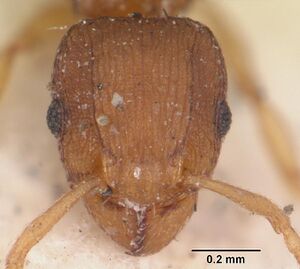   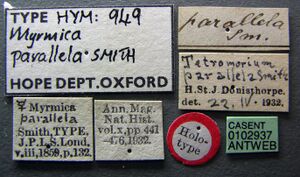
| |
| Worker. Specimen code casent0102937. Photographer April Nobile, uploaded by California Academy of Sciences. | Owned by OUM, Oxford, UK. |
   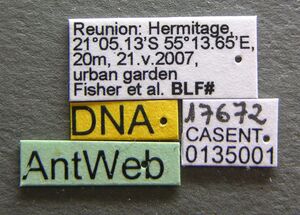
| |
| Worker. Specimen code casent0135001. Photographer April Nobile, uploaded by California Academy of Sciences. | Owned by CAS, San Francisco, CA, USA. |
   
| |
| Worker. Specimen code casent0173318. Photographer April Nobile, uploaded by California Academy of Sciences. | Owned by CAS, San Francisco, CA, USA. |
    
| |
| Worker. Specimen code casent0101495. Photographer April Nobile, uploaded by California Academy of Sciences. | Owned by MNHN, Paris, France. |
  
| |
| Worker. Specimen code casent0173291. Photographer April Nobile, uploaded by California Academy of Sciences. | Owned by CDRS, Galapagos, Ecuador. |
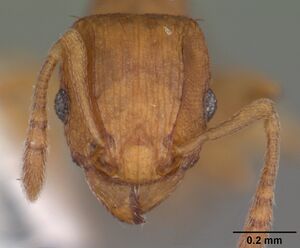 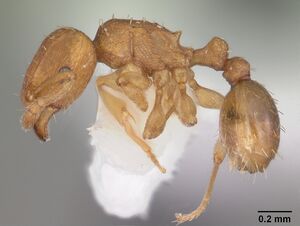 
| |
| Worker. Specimen code casent0102742. Photographer April Nobile, uploaded by California Academy of Sciences. | Owned by ABS, Lake Placid, FL, USA. |
Queen
Images from AntWeb
   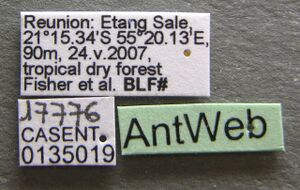
| |
| Queen (alate/dealate). Specimen code casent0135019. Photographer April Nobile, uploaded by California Academy of Sciences. | Owned by CAS, San Francisco, CA, USA. |
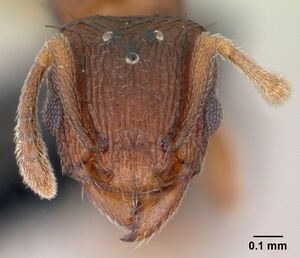   
| |
| Queen (alate/dealate). Specimen code casent0146901. Photographer Erin Prado, uploaded by California Academy of Sciences. | Owned by CAS, San Francisco, CA, USA. |
   
| |
| Queen (alate/dealate). Specimen code casent0173290. Photographer April Nobile, uploaded by California Academy of Sciences. | Owned by CDRS, Galapagos, Ecuador. |
   
| |
| Queen (alate/dealate). Specimen code casent0125195. Photographer April Nobile, uploaded by California Academy of Sciences. | Owned by CAS, San Francisco, CA, USA. |
 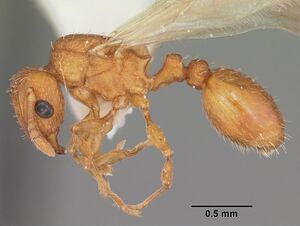   
| |
| Queen (alate/dealate). Specimen code casent0102741. Photographer April Nobile, uploaded by California Academy of Sciences. | Owned by ABS, Lake Placid, FL, USA. |
  
| |
| Queen (alate/dealate). Specimen code casent0060701. Photographer April Nobile, uploaded by California Academy of Sciences. | Owned by CAS, San Francisco, CA, USA. |
Nomenclature
The following information is derived from Barry Bolton's Online Catalogue of the Ants of the World.
- simillimum. Myrmica simillima Smith, F. 1851: 118 (w.) GREAT BRITAIN. Meinert, 1861: 331 (gynandromorph); André, 1883a: 289 (q.m.); Imai, Baroni Urbani, et al. 1984: 8 (k.). Combination in Tetramorium: Mayr, 1861: 61. Senior synonym of pygmaeum: Forel, 1916: 421; of brevispinosa: Borgmeier, 1937b: 241; of insulare: Yarrow, 1967: 28; of denticulatum, opacior, parallela: Bolton, 1977: 131; of bantouana, exoleta and material of the unavailable name breve referred here: Bolton, 1980: 320. See also: Emery, 1909d: 696.
- parallela. Myrmica parallela Smith, F. 1859a: 147 (w.) INDONESIA (Aru I.). Combination in Tetramorium: Donisthorpe, 1932c: 455. Junior synonym of simillimum: Bolton, 1977: 131.
- pygmaeum. Tetramorium pygmaeum Emery, 1877b: 371 (q.) ETHIOPIA. Emery, 1901e: 62 (m.); Emery, 1915g: 17 (w.). Junior synonym of simillimum: Forel, 1916: 421.
- denticulatum. Tetramorium simillimum r. denticulatum Forel, 1902c: 235 (w.) INDIA. Junior synonym of simillimum: Bolton, 1977: 131.
- bantouana. Tetramorium pusillum var. bantouana Santschi, 1910c: 382, fig. 10 (w.q.m.) CONGO. Junior synonym of simillimum: Bolton, 1980: 320.
- opacior. Tetramorium simillimum var. opacior Forel, 1913k: 81 (w.) SRI LANKA. Junior synonym of simillimum: Bolton, 1977: 131.
- exoleta. Tetramorium pusillum var. exoleta Santschi, 1914d: 366 (w.) NIGERIA. Junior synonym of simillimum: Bolton, 1980: 320.
- brevispinosa. Wasmannia auropunctata subsp. brevispinosa Borgmeier, 1928a: 36, figs. 4, 5 (w.) BRAZIL. [Unresolved junior secondary homonym of brevispinosus Stitz, above.] Junior synonym of simillimum: Borgmeier, 1937b: 241.
- insulare. Tetramorium simillimum var. insulare Santschi, 1928c: 69 (w.) FIJI IS. [Unresolved junior secondary homonym of insularis Menozzi, above.] Junior synonym of simillimum: Yarrow, 1967: 28; Bolton, 1977: 131.
Type Material
Bolton (1977) - Syntype workers, Great Britain: England, Dorset (types lost, presumed destroyed). although the types of this species have almost certainly been lost or destroyed at some time in the past (they are not in Smith's material at The Natural History Museum, nor are they at UM, Oxford), the identity of the species does not appear to have ever been in doubt. It is this traditional interpretation which I take as my basis for defining simillimum, and as the species is very widespread and quite well known I can see no obvious reason for designating a neotype.
- Myrmica simillima: Syntype, worker(s) (apparently lost), Dorset, England, United Kingdom of Great Britain and Northern Ireland.
The following notes on F. Smith type specimens have been provided by Barry Bolton (details):
Myrmica parallela
Holotype worker in Oxford University Museum of Natural History. Specimen without locality label, but with a label “simillima” in Smith’s writing. Type-locality “Aru” according to original description. Unless otherwise noted the text for the remainder of this section is reported from the publication that includes the original description.
Wetterer and Hita Garcia (2015) - The species Tetramorium caldarium was described by Roger (1857) from Poland, with the specimens collected from a greenhouse growing pineapples. This species was promptly (Roger 1862) synonymized under T. simillimum, where it remained until 1979 when Bolton revived its status as a valid species. Museum specimens of T. simillimum that do not have contemporary identifications should be examined to be sure they are not T. caldarium (see the identification section of this other species for diagnostic characters).
Description
Worker
(length3/4 - 1 line). Head and thorax pale ferruginous, the legs and antennae more pallid, the coxae a little coloured, the eyes black; the abdomen is rufo-fuscous, pale towards the apex; the head is evenly longitudinally striate; the thorax above is without the usual transverse suture, but is a little compressed at the sides about the middle, and gradually slightly narrowed from the prothorax towards the nodes of the peduncle; the metathorax is truncate at the apex, and the spines are short, broad, and acute; the abdomen is furnished with a few scattered erect hairs.
Bolton (1977) - TL 2.1-2.5, HL 0.54-0.60, HW 0.48-0.54, CI 88-93, SL 0.36-0.42, SI 74-80, PW 0.34-0.40, AL 0.58-0.68 (45 measured).
Mandibles finely and usually weakly sculptured, appearing usually as feeble striation or weak shagreening but sometimes more or less dully shining with only superficial sculpture. Anterior clypeal margin entire. Frontal carinae distinct, extending back almost to the occiput and very shallowly, evenly convex along their length. Antennal scrobes broad and quite shallow, but distinct. Eyes moderate in size, maximum diameter c. 0.11-0.14, about 0.22-0.26 x HW. Occipital margin in full-face view broadly and shallowly concave, the sides of the head behind the eyes sometimes roughly parallel but usually weakly convex; occipital corners evenly rounded. Propodeum armed with a pair of short, triangular acute teeth which are usually shorter than the metapleural lobes, rarely very slightly longer. Metapleural lobes broad, roughly triangular in shape. Petiole in profile with a stout anterior peduncle, the outline shape of the node as shown in figure, but in some populations the node tending to narrow very slightly from base to apex. In dorsal view the node always slightly broader than long, somewhat variable in shape but always broadened posteriorly before narrowing to the postpetiolar junction. Dorsum of head finely and quite densely longitudinally rugulose, the spaces between the rugulae filled with a fine, dense conspicuous reticulate-punctulation or granulation. Area of antennal scrobes densely and finely reticulate-punctulate. Dorsal alitrunk finely, often faintly longitudinally rugulose, with traces of reticulation on pronotum, the spaces between the rugulae densely punctulate. Dorsal petiole and postpetiole similarly but less strongly sculptured, the sculpture sometimes reduced but never completely absent, always with traces of punctulation and nearly always with traces of faint rugulation. Sides of alitrunk densely and conspicuously reticulate-punctate. Gaster unsculptured. All dorsal surfaces of head and body with scattered short hairs, generally longer on the gaster than elsewhere. Hairs on ali trunk conspicuous, short, stout and blunt. Antennal scapes and dorsal (outer) surfaces of hind tibiae only with very short, fine, appressed pubescence. Colour yellow to yellowish brown, usually with the gaster darker brown but some populations uniformly coloured.
Karyotype
- See additional details at the Ant Chromosome Database.
 Explore: Show all Karyotype data or Search these data. See also a list of all data tables or learn how data is managed.
Explore: Show all Karyotype data or Search these data. See also a list of all data tables or learn how data is managed.
- 2n = 14 (India) (Imai et al., 1984).
References
- Bolton, B. 1980. The ant tribe Tetramoriini (Hymenoptera: Formicidae). The genus Tetramorium Mayr in the Ethiopian zoogeographical region. Bulletin of the British Museum (Natural History) Entomology. 40(3):193-384.
- Agavekar, G., Hita Garcia, F., Economo, E.P. 2017. Taxonomic overview of the hyperdiverse ant genus Tetramorium Mayr (Hymenoptera, Formicidae) in India with descriptions and X-ray microtomography of two new species from the Andaman Islands. PeerJ 5:e3800 (DOI 10.7717/peerj.3800).
- Albuquerque, E., Prado, L., Andrade-Silva, J., Siqueira, E., Sampaio, K., Alves, D., Brandão, C., Andrade, P., Feitosa, R., Koch, E., Delabie, J., Fernandes, I., Baccaro, F., Souza, J., Almeida, R., Silva, R. 2021. Ants of the State of Pará, Brazil: a historical and comprehensive dataset of a key biodiversity hotspot in the Amazon Basin. Zootaxa 5001, 1–83 (doi:10.11646/zootaxa.5001.1.1).
- André, E. 1883a. Les fourmis. [part]. Pp. 281-344 in: André, Edm. 1881-1886. Species des Hyménoptères d'Europe et d'Algérie. Tome Deuxième. Beaune: Edmond André, 919 + 48 pp. (page 289, queen, male described)
- Bharti, H. & Kumar, R. 2012. Taxonomic studies on genus Tetramorium Mayr (Hymenoptera, Formicidae) with report of two new species and three new records including a tramp species from India with a revised key. ZooKeys. 207:11-35. doi:10.3897/zookeys.207.3040
- Blard, F., Dorow, W.-H.-O., Delabie, J. H. C. 2003. Les Fourmis de l’île de la Réunion (Hymenoptera, Formicidae). Bulletin de La Société Entomologique de France, 108(2), 127–137 (doi:10.3406/bsef.2003.16939).
- Bolton, B. 1977. The ant tribe Tetramoriini (Hymenoptera: Formicidae). The genus Tetramorium Mayr in the Oriental and Indo-Australian regions, and in Australia. Bulletin of the British Museum (Natural History). Entomology. 36:67-151. (page 131, Senior synonym of denticulatum, opacior and parallela)
- Bolton, B. 1979. The ant tribe Tetramoriini (Hymenoptera: Formicidae). The genus Tetramorium Mayr in the Malagasy region and in the New World. Bull. Br. Mus. (Nat. Hist.) Entomol. 38: 129-181 (see also)
- Borgmeier, T. 1937b. Formigas novas ou pouco conhecidas da América do Sul e Central, principalmente do Brasil (Hym. Formicidae). Arch. Inst. Biol. Veg. (Rio J.) 3: 217-255 (page 241, Senior synonym of brevispinosa)
- Borowiec, L. 2014. Catalogue of ants of Europe, the Mediterranean Basin and adjacent regions (Hymenoptera: Formicidae). Genus (Wroclaw) 25(1-2): 1-340.
- Borowiec, L., Salata, S. 2019. Next step in the invasion: Trichomyrmex mayri (Forel, 1902) new to the Philippines (Hymenoptera: Formicidae). Annals of the Upper Silesian Museum in Bytom Entomology 28:1-3 (doi:10.5281/ZENODO.2644912).
- Chan, K.-W. 2024. New records of the ant species Tetramorium walshi (Forel, 1890) (Hymenoptera: Formicidae) from Taiwan, with additional reports of Tetramorium species from Penghu Islands. Taiwanese Society of Insect Natural History 9(3): 22–28 (doi:10.5281/ZENODO.13839248).
- Collingwood, C. A. 1979. The Formicidae (Hymenoptera) of Fennoscandia and Denmark. Fauna Entomol. Scand. 8:1-174.
- Collingwood, C. A., Pohl, H., Guesten, R., Wranik, W. and van Harten A. 2004. The ants (Insecta: Hymenoptera: Formicidae) of the Socotra Archipelago. Fauna of Arabia 20: 473-495.
- Csősz, S., Báthori, F., Gallé, L., Lőrinczi, G., Maák, I., Tartally, A., Kovács, É., Somogyi, A.Á., Markó, B. 2021. The myrmecofauna (Hymenoptera: Formicidae) of Hungary: Survey of ant species with an annotated synonymic inventory. Insects 16;12(1):78 (doi:10.3390/insects12010078).
- Csosz, S., Marko, B., Galle, L. 2011. The myrmecofauna (Hymenoptera: Formicidae) of Hungary: an updated checklist. North-Western Journal of Zoology 7: 55-62.
- Czechowski, W., Radchenko, A., Czechowska, W. 2002. The ants (Hymenoptera, Formicidae) of Poland. MIZ PAS Warsaw.
- Dekoninck, W., Wauters, N., Delsinne, T. 2019. Capitulo 35. Hormigas invasoras en Colombia. Hormigas de Colombia.
- Deyrup, M., Davis, L. & Cover, S. 2000. Exotic ants in Florida. Transactions of the American Entomological Society 126, 293-325.
- Deyrup, M.A., Carlin, N., Trager, J., Umphrey, G. 1988. A review of the ants of the Florida Keys. Florida Entomologist 71: 163-176.
- Emery, C. 1909f. Beiträge zur Monographie der Formiciden des paläarktischen Faunengebietes. (Hym.) Teil IX. Dtsch. Entomol. Z. 1909: 695-712 (page 696, see also)
- Farias, E.S., Santos, R.C., Carmo, D.G., Soares, J.R.S., Costa, T.L., Santos, A.A., Picanço, M.C. 2020. Life tables for the diamondback moth (Plutella xylostella) in southeast Brazil indicate ants and spiders as leading mortality factors. Annals of Applied Biology, aab.12656. (doi:10.1111/aab.12656).
- Fontenla, J.L., Brito, Y.M. 2011. Hormigas invasoras y vagabundas de Cuba. Fitosanidad 15(4), 253-259.
- Forel, A. 1916. Fourmis du Congo et d'autres provenances récoltées par MM. Hermann Kohl, Luja, Mayné, etc. Rev. Suisse Zool. 24: 397-460 (page 421, Senior synonym of pygmaeum)
- Franco, W., Ladino, N., Delabie, J.H.C., Dejean, A., Orivel, J., Fichaux, M., Groc, S., Leponce, M., Feitosa, R.M. 2019. First checklist of the ants (Hymenoptera: Formicidae) of French Guiana. Zootaxa 4674, 509–543 (doi:10.11646/zootaxa.4674.5.2).
- Hasin, S., Tasen, W. 2020. Ant community composition in urban areas of Bangkok, Thailand. Agriculture and Natural Resources 54: 507-514 (doi:10.34044/j.anres.2020.54.5.07).
- Herrera, H.W., Baert, L., Dekoninck, W., Causton, C.E., Sevilla, C.R., Pozo, P., Hendrickx, F. 2020. Distribution and habitat preferences of Galápagos ants (Hymenoptera: Formicidae). Belgian Journal of Entomology, 93: 1–60.
- Heterick, B. E. 2009. A guide to the ants of South-western Australia. Records of the Western Australian Museum, Supplement 76:1-206.
- Heterick, B.E. 2021. A guide to the ants of Western Australia. Part I: Systematics. Records of the Western Australian Museum, Supplement 86, 1-245 (doi:10.18195/issn.0313-122x.86.2021.001-245).
- Hoffmann, B., Eldridge, J., Marston, C. 2023. The first eradication of an exotic ant species from the entirety of Australia: Pheidole fervens. Management of Biological Invasions, 14(4), 619–624 (doi:10.3391/mbi.2023.14.4.03).
- Imai, H. T.; Baroni Urbani, C.; Kubota, M.; Sharma, G. P.; Narasimhanna, M. H.; Das, B. C.; 1984. Karyological survey of Indian ants. Jpn. J. Genet. 59: 1-32 (page 8, karyotype described)
- Imai, H.T., Kihara, A., Kondoh, M., Kubota, M., Kuribayashi, S., Ogata, K., Onoyama, K., Taylor, R.W., Terayama, M., Yoshimura, M., Ugawa, Y. 2003. Ants of Japan. 224 pp, Gakken, Japan.
- Katayama, M., Tsuji, K. 2010. Habitat differences and occurrence of native and exotic ants on Okinawa Island. Entomological Science 13, 425–429 (doi:10.1111/j.1479-8298.2010.00400.x).
- Khachonpisitsak, S., Yamane, S., Sriwichai, P., Jaitrong, W. 2020. An updated checklist of the ants of Thailand (Hymenoptera, Formicidae). ZooKeys 998, 1–182 (doi:10.3897/zookeys.998.54902).
- Koch, E.B.de A., Marques, T.E.D., Mariano, C.S.F., Neto, E.A.S., Arnhold, A., Peronti, A.L.B.G., Delabie, J.H.C. 2020. Diversity and structure preferences for ant-hemipteran mutualisms in cocoa trees (Theobroma cacao L., Sterculiaceae). Boletim do Museu Paraense Emílio Goeldi - Ciências Naturais 15, 65–81 (doi:10.46357/bcnaturais.v15i1.251).
- Lee, C.-C., Weng, Y.-M., Lai, L.-C., Suarez, A.V., Wu, W.-J., Lin, C.-C., Yang, C.-C.S. 2020. Analysis of recent interception records reveals frequent transport of arboreal ants and potential predictors for ant invasion in Taiwan. Insects 11, 356 (doi:10.3390/INSECTS11060356).
- Lubertazzi, D. 2019. The ants of Hispaniola. Bulletin of the Museum of Comparative Zoology, 162(2), 59-210 (doi:10.3099/mcz-43.1).
- Mayr, G. 1861. Die europäischen Formiciden. Nach der analytischen Methode bearbeitet. Wien: C. Gerolds Sohn, 80 pp. (page 61, Combination in Tetramorium)
- Meinert, F. 1861. Bidrag til de danske Myrers Naturhistorie. K. Dan. Vidensk. Selsk. Skr. (5) 5: 273-340 (page 331, gynandromorph)
- Melo, T.S., Koch, E.B.A., Andrade, A.R.S., Travassos, M.L.O., Peres, M.C.L., Delabie, J.H.C. 2021. Ants (Hymenoptera: Formicidae) in different green areas in the metropolitan region of Salvador, Bahia state, Brazil. Brazilian Journal of Biology 82, e236269 (doi:10.1590/1519-6984.236269).
- Meurgey, F. 2020. Challenging the Wallacean shortfall: A total assessment of insect diversity on Guadeloupe (French West Indies), a checklist and bibliography. Insecta Mundi 786: 1–183.
- Nsengimana, V., Hagenimana, T., Barakagwira, J., de Dieu Nsenganeza, J., Iradukunda, S. C., Majyambere, M., Kizungu, O. B., Nkundimana, A., Umutoni, D., Fabrice, R., Cyubahiro, B., Kouakou, L. M., Kolo, Y., Anale, J. S., Gómez, K., Dekoninck, W. 2023. Checklist of ant (Hymenoptera: Formicidae) species from Nyungwe Tropical Rain Forest, south-western Rwanda. Journal of East African Natural History 111(2), 69-81 (doi:10.2982/028.111.0203).
- Oussalah, N., Marniche, F., Espadaler, X., Biche, M. 2019. Exotic ants from the Maghreb (Hymenoptera, Formicidae) with first report of the hairy alien ant Nylanderia jaegerskioeldi (Mayr) in Algeria. Arxius de Miscel·lània Zoològica, 45–58 (doi:10.32800/amz.2019.17.0045).
- Rafael, J.A., Limeira-de-Oliveira, F., Hutchings, R.W., Miranda, G.F.G., Silva Neto, A.M.da, Somavilla, A., Camargo, A., Asenjo, A., Pinto, Â.P., Bello, A.de M., Dalmorra, C., Mello-Patiu, C.A.de, Carvalho, C.J.B.de, Takiya, D.M., Parizotto, D.R., Marques, D.W.A., Cavalheiro, D.de O., Mendes, D.M.de M., Zeppelini, D., Carneiro, E., Lima, É.F.B., Lima, E.C.A.de, Godoi, F.S.P.de, Pessoa, F.A.C., Vaz-de-Mello, F.Z., Sosa-Duque, F.J., Flores, H.F., Fernandes, I.O., Silva-Júnior, J.O., Gomes, L.R.P., Monné, M.L., Castro, M.C.M.de, Silva, M.P.G.da, Couri, M.S., Gottschalk, M.S., Soares, M.M.M., Monné, M.A., Rafael, M.S., Casagrande, M.M., Mielke, O.H.H., Grossi, P.C., Pinto, P.J.C., Bartholomay, P.R., Sobral, R., Heleodoro, R.A., Machado, R.J.P., Corrêa, R.C., Hutchings, R.S.G., Ale-Rocha, R., Santos, S.D.dos, Lima, S.P.de, Mahlmann, T., Silva, V.C., Fernandes, D.R.R. 2020. Insect (Hexapoda) diversity in the oceanic archipelago of Fernando de Noronha, Brazil: updated taxonomic checklist and new records. Revista Brasileira de Entomologia 64, e20200052 (doi:10.1590/1806-9665-rbent-2020-0052).
- Rosas-Mejía, M., Guénard, B., Aguilar-Méndez, M. J., Ghilardi, A., Vásquez-Bolaños, M., Economo, E. P., Janda, M. 2021. Alien ants (Hymenoptera: Formicidae) in Mexico: the first database of records. Biological Invasions 23(6), 1669–1680 (doi:10.1007/s10530-020-02423-1).
- Salata, S., Khalili-Moghadam, A., Borowiec, L. 2024. A new species of the Tetramorium meridionale species-group (Hymenoptera: Formicidae) from Iran. Zoology in the Middle East 70, 161–175 (doi:10.1080/09397140.2024.2359167).
- Sanetra, M., Buschinger, A. 2000. Phylogenetic relationships among social parasites and their hosts in the ant tribe Tetramoriini (Hymenoptera: Formicidae). European Journal of Entomology 97: 95-117.
- Sharaf, M.R., Abdel-Dayem, M.S., Mohamed, A.A., Fisher, B.L., Aldawood, A.S. 2020. A preliminary synopsis of the ant fauna (Hymenoptera: Formicidae) of Qatar with remarks on the zoogeography. Annales Zoologici 70: 533-560 (doi:10.3161/00034541anz2020.70.4.005).
- Sharaf, M.R., Fisher, B.L., Collingwood, C.A., Aldawood, A.S. 2017. Ant fauna (Hymenoptera: Formicidae) of the Socotra Archipelago (Yemen): zoogeography, distribution and description of a new species. Journal of Natural History 51, 317–378 (DOI 10.1080/00222933.2016.1271157).
- Smith, F. 1851. List of the specimens of British animals in the collection of the British Museum. Part VI. Hymenoptera, Aculeata. London: British Museum, 134 pp. (page 118, worker described)
- Varela-Hernández, F., Medel-Zosayas, B., Martínez-Luque, E.O., Jones, R.W., De la Mora, A. 2020. Biodiversity in central Mexico: Assessment of ants in a convergent region. Southwestern Entomologist 454: 673-686.
- Wetterer, J.K. 2017. Invasive ants of Bermuda revisited. Journal of Hymenoptera Research 54, 33–41 (doi:10.3897/jhr.54.11444).
- Wetterer, J.K., Wetterer, A.L. 2004. Ants (Hymenoptera: Formicidae) of Bermuda. Florida Entomologist 87(2), 212–221 (doi:10.1653/0015-4040(2004)087[0212:ahfob2.0.CO;2]).
- Wheeler, W. M. 1905c. The ants of the Bahamas, with a list of the known West Indian species. Bull. Am. Mus. Nat. Hist. 21: 79-135
- Wheeler, W. M. 1908a. The ants of Porto Rico and the Virgin Islands. Bull. Am. Mus. Nat. Hist. 24: 117-158.
- Yamane, S., Hosoishi, S., Ito, F. 2022. Japanese Tetramorium queens: identification key and species diagnoses (Hymenoptera, Formicidae, Myrmicinae). ZooKeys 1084: 43–64 (doi:10.3897/zookeys.1084.69767).
- Yarrow, I. H. H. 1967. On the Formicidae of the Azores. Bol. Mus. Munic. Funchal 21: 24-32 (page 28, Senior synonym of insulare)
- Yu, Y. 2016. Risk of alien species introduction to Ogasawara Islands : Case study of ants at Tokyo Port. World Heritage Studies 1, 86-89.
References based on Global Ant Biodiversity Informatics
- Arnold G. 1917. A monograph of the Formicidae of South Africa. Part III. Myrmicinae. Annals of the South African Museum. 14: 271-402.
- Bernard F. 1953. La réserve naturelle intégrale du Mt Nimba. XI. Hyménoptères Formicidae. Mémoires de l'Institut Français d'Afrique Noire 19: 165-270.
- Bolton B. 1977. The ant tribe Tetramoriini (Hymenoptera: Formicidae). The genus Tetramorium Mayr in the Oriental and Indo-Australian regions, and in Australia. Bulletin of the British Museum (Natural History). Entomology 36:67-151.
- Bolton B. 1980. The ant tribe Tetramoriini (Hymenoptera: Formicidae). The genus Tetramorium Mayr in the Ethiopian zoogeographical region. Bulletin of the British Museum (Natural History). Entomology 40: 193-384.
- Bolton, B. "The ant tribe Tetramoriini (Hymenoptera: Formicinae. The genus Tetramorium Mayr in the Oriental and Indo-Australian regions and in Australia." Bulletin of the British Museum (National History): Entomology series 36, no. 2 (1977): 68-151.
- Borowiec L. 2014. Catalogue of ants of Europe, the Mediterranean Basin and adjacent regions (Hymenoptera: Formicidae). Genus (Wroclaw) 25(1-2): 1-340.
- Braet Y., and B. Taylor. 2008. Mission entomologique au Parc National de Pongara (Gabon). Bilan des Formicidae (Hymenoptera) recoltes. Bulletin S. R. B. E./K.B.V.E. 144: 157-169.
- Collingwood C.A., and A. Van Harten. 1993. The ants (Hymenoptera: Formicidae) of the Cape Verde Islands. Beitrag zur Fauna und Flora der Kapverdischen Inseln : Ergebnisse des 5. Symposiums in Leiden 159: 411-414.
- Davis L. R., and L. E. Alonso. 2007. Ant species collected from the Atewa Range Forest Reserve during the 2006 RAP survey. Pp 171-172. McCullough, J., L.E. Alonso, P. Naskrecki, H.E. Wright and Y. Osei-Owusu (eds.). 2007. A Rapid Biological Assessment of the Atewa Range Forest Reserve, Eastern Ghana. RAP Bulletin of Biological Assessment 47. Conservation International, Arlington, VA.
- Diame L., B. Taylor, R. Blatrix, J. F. Vayssieres, J. Y. Rey, I. Grechi, and K. Diarra. 2017. A preliminary checklist of the ant (Hymenoptera, Formicidae) fauna of Senegal. Journal of Insect Biodiversity 5(15): 1-16.
- Emery, C. "Catalogo delle formiche esistenti nelle collezioni del Museo Civico di Genova. Parte prima. Formiche provenienti dal Viaggio dei signori Antinori, Beccari e Issel nel Mar Rosso e nel paese dei Bogos. [concl.]." Annali del Museo Civico di Storia Naturale 9 (1877): 363-381.
- Finzi, B. "Risultati scientifici della spedizione di S. A. S. il Principe Alessandro della Torre e Tasso nell'Egitto e peninsola del Sinai. XI. Formiche." Bulletin de la Société Entomologique d'Egypte 20 (1936): 155-210.
- Forel A. 1907. Formicides du Musée National Hongrois. Ann. Hist.-Nat. Mus. Natl. Hung. 5: 1-42.
- Forel A. 1914. Formicides d'Afrique et d'Amérique nouveaux ou peu connus. Bulletin de la Société Vaudoise des Sciences Naturelles 50: 211-288.
- Fotso Kuate A., R. Hanna, M. Tindo, S. Nanga, and P. Nagel. 2015. Ant diversity in dominant vegetation types of Southern Cameroon. Biotropica 1-7. (10.1111/btp.12182)
- Garcia F.H., Wiesel E. and Fischer G. 2013.The Ants of Kenya (Hymenoptera: Formicidae)Faunal Overview, First Species Checklist, Bibliography, Accounts for All Genera, and Discussion on Taxonomy and Zoogeography. Journal of East African Natural History, 101(2): 127-222
- IZIKO South Africa Museum Collection
- Karavaiev V. 1911. Ameisen aus Aegypten und dem Sudan. Rus. Entomol. Obozr. 11: 1-12.
- Kouakou L. M. M., K. Yeo, K. Ouattara, W. Dekoninck, T. Delsinne, and S. Konate. 2018. Investigating urban ant community (Hymenoptera: Formicidae) in port cities and in major towns along the border in Côte d’Ivoire: a rapid assessment to detect potential introduced invasive ant species. Journal of Animal and Plant Sciences 36(1): 5793-5811.
- Kouakou L. M. M., W. Dekoninck, M. Kone, T. Delsinne, K. Yeo, K. Ouattara, and S. Konate. 2018. Diversity and distribution of introduced and potentially invasive ant species from the three main ecoregions of Côte d’Ivoire (West Africa). Belgian Journal of Zoology 148 (1): 83–103.
- Levieux J. 1972. Etude du peuplement en fourmis terricoles d'une savane preforestiere de Cote d'Ivoire. Revue d'Ecologie et de Biologie du Sol 10(3): 381-428.
- Lévieux J. 1972. Les fourmis de la savane de Lamto (Côte d'Ivoire): éléments de taxonomie. Bulletin de l'Institut Fondamental d'Afrique Noire. Série A. Sciences Naturelles 34: 611-654.
- Madl M. 2019. Notes on the ant fauna of Eritrea (Insecta: Hymenoptera: Formicidae): type specimens deposited in the Natural History Museum Vienna (Austria) and a preliminary checklist. Ann. Naturhist. Mus. Wien, B 121: 9-18.
- Nsengimana V., K. A. Beth, F. Frederic, K. M. M. Lombart, D. Wouter, and N. Donat. 2018. Use of soil and litter ants (Hymenoptera: Formicidae) as biological indicators of soil quality under different land uses in Southern Rwanda. Environmental Entomology 47(6): 1394-1401.
- Santschi F. 1910. Formicides nouveaux ou peu connus du Congo français. Annales de la Société Entomologique de France 78: 349-400.
- Santschi F. 1914. Formicides de l'Afrique occidentale et australe du voyage de Mr. le Professeur F. Silvestri. Bollettino del Laboratorio di Zoologia Generale e Agraria della Reale Scuola Superiore d'Agricoltura. Portici 8: 309-385.
- Stephens S. S., P. B. Bosu, and M. R. Wager. 2016. Effect of overstory tree species diversity and composition on ground foraging ants (Hymenoptera: Formicidae) in timber plantations in Ghana. International Journal of Biodiversity Science, Ecosystem Services & management 12(1-2): 96-107.
- Weber N. A. 1941. Four new genera of Ethiopian and Neotropical Formicidae. Ann. Entomol. Soc. Am. 34: 183-194.
- Weber N. A. 1943. The ants of the Imatong Mountains, Anglo-Egyptian Sudan. Bulletin of the Museum of Comparative Zoology 93: 263-389.
- Wheeler W. M. 1922. Ants of the American Museum Congo expedition. A contribution to the myrmecology of Africa. II. The ants collected by the American Museum Congo Expedition. Bulletin of the American Museum of Natural History 45: 39-269.
- Wheeler W. M. 1922. Ants of the American Museum Congo expedition. A contribution to the myrmecology of Africa. VIII. A synonymic list of the ants of the Ethiopian region. Bulletin of the American Museum of Natural History 45: 711-1004
- Yeo K., L. M. M. Kouakou, W. Dekoninck, K. Ouattara, and S. Konate. 2016. Detecting intruders: assessment of the anthropophilic ant fauna (Hymenoptera: Formicidae) in the city of Abidjan and along access roads in Banco National Park (Côte d’Ivoire). Journal of Entomology and Zoological Studies 4(4): 351-359.
- Pages using DynamicPageList3 parser function
- Common Name
- Highly invasive
- Polygynous
- North subtropical
- Tropical
- South subtropical
- Cestode Associate
- Host of Raillietina echinobothrida
- Host of Raillietina tetragona
- Karyotype
- Species
- Extant species
- Formicidae
- Myrmicinae
- Crematogastrini
- Tetramorium
- Tetramorium simillimum
- Myrmicinae species
- Crematogastrini species
- Tetramorium species
- Ssr

